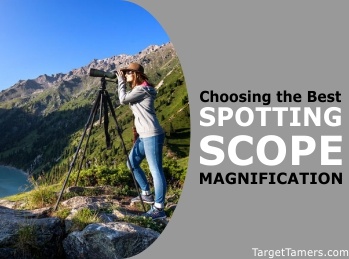
There's no doubt that the most commonly-asked questions when it comes to buying spotting scopes is what magnification you'll need for your style of hunting or for target shooting.
And unfortunately, the answers aren't as black and white as you may want.
To better understand one of the least understood features of sport optics, we'll discuss in detail the most important things you need to know before buying a great spotting scope.
We'll go over the truth about magnification, other factors involved in distance clarity, and we'll also throw out some recommendations for the best spotting scope magnification for hunting to give you an idea where to start before you buy.
So, let's start from the beginning...
How to Choose a Spotting Scope
Being able to read all the numbers, abbreviations, and optical terms associated with sport optics will give you a big heads-up when you're wading the ocean of scopes in the market.
And, the first question usually asked is...
What do the numbers mean on a spotting scope?
Spotting scopes, binocular, and rifle scopes are all identified by their magnification range and objective lens sizes. These two numbers together are what I often call the magnification and objective lens size combo or platform.
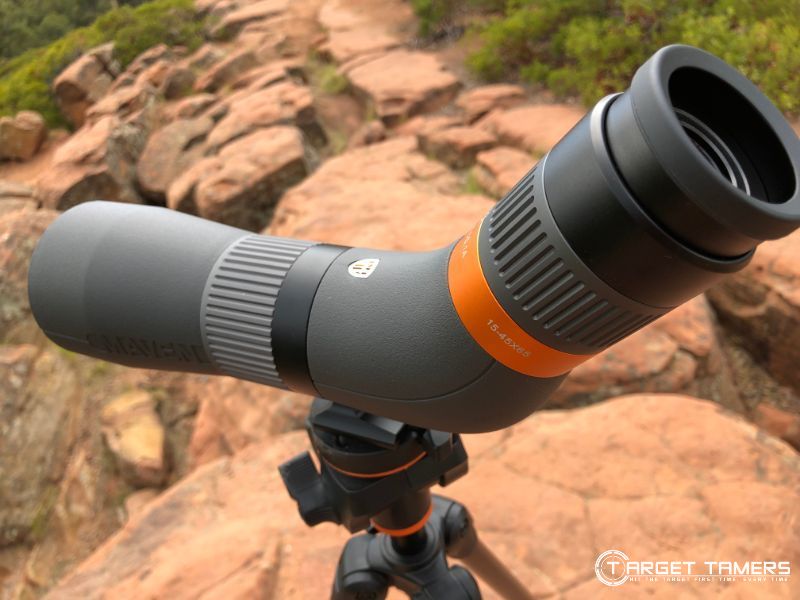
Let's go over a 20-60X80 spotting scope as an example:
20-60 is the magnification/power range
- All numbers left of the "X" are representative of the magnification/power range
- The symbol "X" indicates power
- Your image will be magnified 20-60X larger than what you see with the naked eye at the distance you are at
80 is the objective lens size
- The numbers right of the "X" are representative of the objective lens size
- This size is measured in millimeters (mm)
Additionally, magnification ranges can be fixed, meaning that they don't enlarge or shrink the image (zooming power). If a spotting scope eyepiece has a platform of 30X60, the image will be always fixed at 30 times larger than what you see without it.
When choosing spotting scope magnification ask yourself a few things.
- How much do you want to spend on a spotting scope?
- Are you close range shooting or long range shooting?
- What types of targets are you using?
- Is it going to be a dual-purpose scope - for the range and the field?
- Does weight and size matter?
- Under what conditions are you mostly going to be using it in?
If you can answer these questions, you'll have a better idea of how to narrow down on the many scopes available for you to buy.
The Truth About Magnification
Now that you know how to read and determine what the numbers mean on a spotting scope, let's go over some of the common myths about magnification that can set you back when you're out in the field or on the range.
1. Myth: Bigger is Better
What power spotting scope is best for hunting? Bigger should equal better right? Well, in the typical marketplace, that theme is always being touted as better, but it's not always the case. Although being able to see an image 60X larger sounds enticing, there will be set-backs as you increase magnification. What are they?
- Decreased field of view - you see less of an area
- Decreased brightness - light is needed to be spread over a larger area of the entire image
- Increased image instability - vibrations will degrade image quality
- Degrading image quality as atmospheric conditions are enhanced
- Few spotting scopes have the optical build required to provide the needed quality for images at high magnifications of 60X and more.
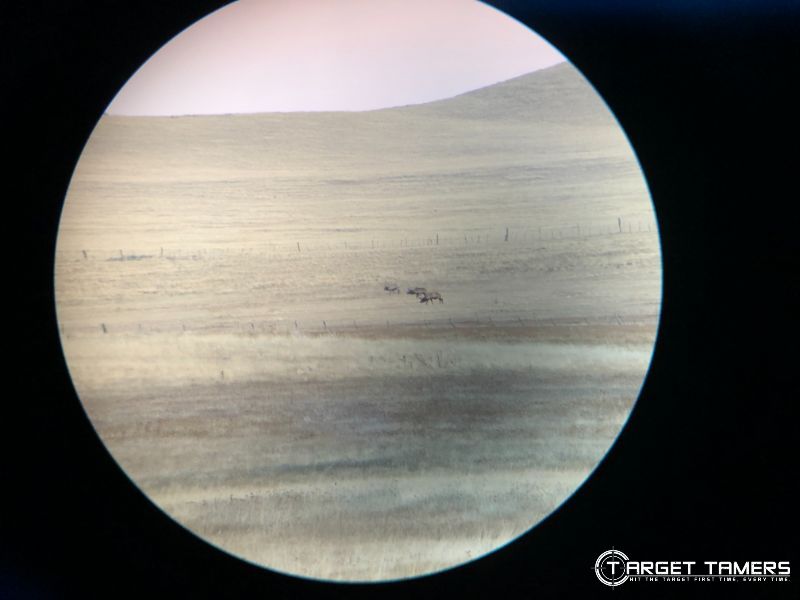
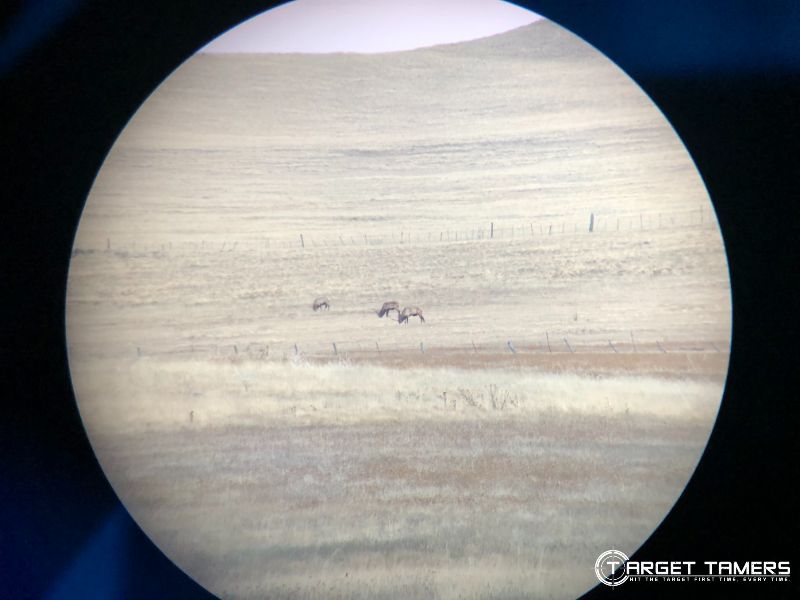
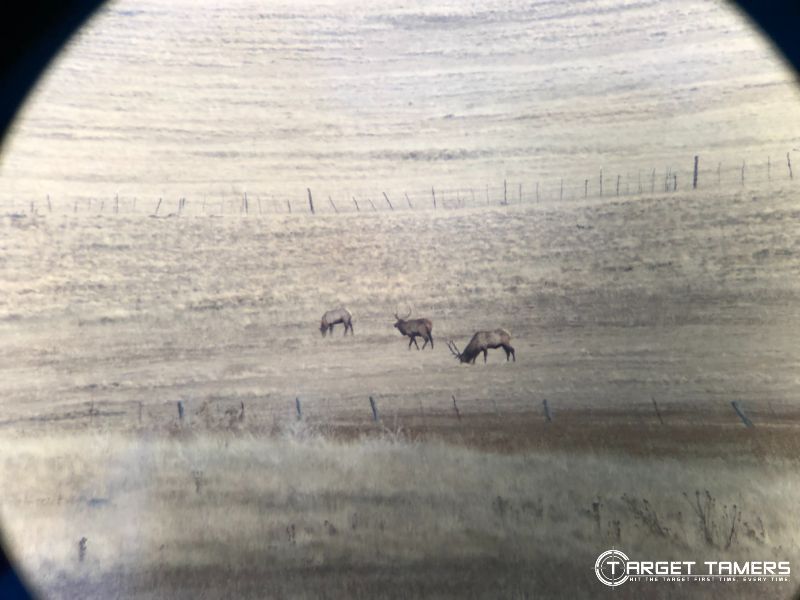
2. Fixed vs Zoom Eyepieces
Admittedly, fixed eyepieces do provide better optical performance than zoom eyepieces. That's because they offer a larger field of view and more clarity and brightness overall. But, they often serve for different purposes.
Think of it this way, if you want excellent image quality where your hunting includes for some photography or digiscoping of some sort, then go with the fixed eyepiece. You will also have to remember the time it takes to switch out eyepieces if you want more power and then adjust the scope each time for focused images.
If you want an excellent hunting and shooting tool to scan, locate, and zoom in for details, go with a zoom eyepiece. You'll save time, weight, and money not having to buy, pack, tote, and switch out eyepieces.
Of course, not all zoom eyepieces are made equal. Some quality fixed eyepieces may be better options over cheap zoom eyepieces. As it's often said with optics, buy the best of what you can afford.
3. Quality Optics vs Mother Nature
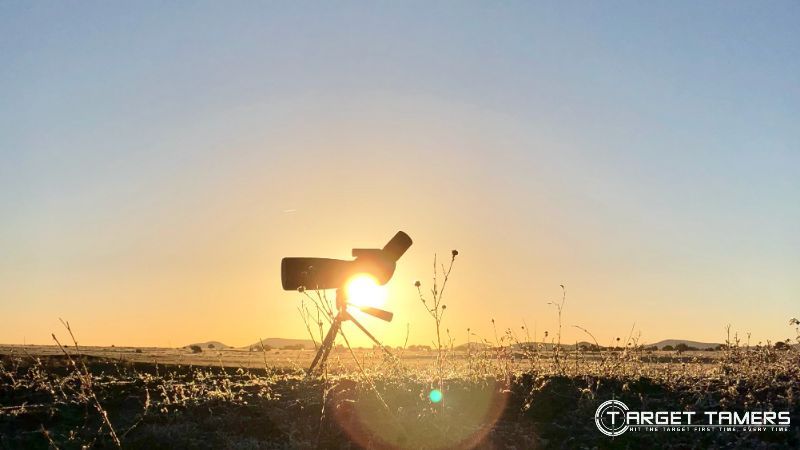
How many times have you headed to the range only to find that it was pretty much useless because you couldn't see through the scope? You figure some days it wants to cooperate and other days it doesn't. Well, in defense of the spotting scope, it's not its fault, and it has nothing to do with magnification.
Even the most expensive and highest-quality spotting scopes will be rendered useless if the conditions aren't right - this is what adds to a spotting scope's difficulty of use over binoculars.
They are very sensitive to atmospheric conditions such as heat mirage, wind, humidity, and whatever else Mother Nature wants to throw at you. And, as you increase magnification, you just make it worse. So, to really see the full power and potential of a spotting scope, you'll want to see it in use during ideal conditions.
4. Myth: A Quality Spotting Scope Can Replace All Other Equipment
Wrong! Spotting scopes should be an addition and supplement to all your sporting equipment. Out in the hunt, even though it's further reach than what your binos can get, it shouldn't be an instant replacement. Use it as a supplement to get even more clarity and close-up details once you've found your target with the binoculars.
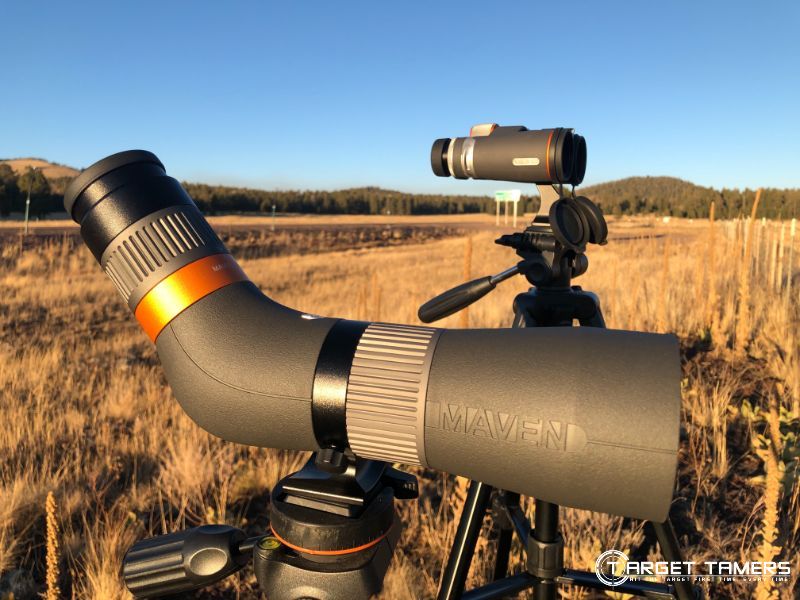
At the target range, you can spot those long shot groups for yourself. But, it's not just a spotter that has an important role here, visibility also depends on the type of targets you use and size of the caliber.
On an ideal day, your low budget spotting scope may be able to impressively see groups of .30 cals at 600 yards on white paper. But, as atmospheric disturbances change by the hour, you might want to switch out your targets. You might have to consider splatter or shoot-n-see targets just to be able to see those same groupings at 200 yards, even if your scope is a $4000 one.
To enhance the performance of your spotting scope, make sure you have the appropriate targets for the range - despite magnification prowess. In the field, always keep a binocular handy to conveniently scan an area before you pull out the spotting scope - it'll save you some time if you end up moving on or it'll be faster at locating that moving herd as a precursor to the spotter for more details.
What's More Important Than Magnification?
So, if magnification isn't the end-all for getting clarity at long distances, what is?
More important than magnification range is the quality of glass and coatings.
Chromatic aberration is bound to happen the higher the magnification and the longer the distance. Just how bad it gets will depend on the quality of the scope.
A Barska spotting scope with a 20-60X60 platform isn't going to have the same distance "reach" as a as a Zeiss 18-45X65, never mind clarity, sharpness, and brightness. Even though the Zeiss has less power range, the quality glass and coatings of the Zeiss scope will actually surpass the distance "reach" of the higher power, low budget Barska. With the Zeiss, you'll be able to see hundreds of yards away whereas the Barska might get you to 200 yards - tops.
But, then again, you're spending thousands of dollars more for the Zeiss than you would for a Barska. So, the reasoning seems to be, you only need to spend around $100-$300 to see groupings at 100 yards and you'll have to spend upwards of $2000 to see the same group at 1000 yards. This is where we get into spotting scopes for specific yardages.
What Power Spotting Scope For...
This is the part that you've all been waiting for... our recommendations on which spotting scope for target shooting and hunting is best for specific yardages. Here, we'll assume favorable atmospheric conditions to get the most out of your spotting scope.
Best Spotting Scope for 25-75 Yards
If you're looking for a spotting scope that'll work between 25-75 yards, you don't need one - your binoculars or rifle scope will work just fine. After all, you're either doing some real close-range hunting or you're sighting-in for air rifles or rim fire rifles at the range.
But, if you like the stability a tripod provides, your binoculars are probably tripod adaptable too, and they're easier to look through since you can use two eyes. But, if you're unconvinced and you want a spotting scope for these distances, look at a very low powered spotter to save some money and something that excels in clarity and close focus versus high magnification and large objectives.
Many spotting scopes can't be focused for closer distances than 25 feet, so if you're doing some close-range shooting or bird watching, look for a close focus distance that more suits your needs.
- Low power: 8-24X, 10-25, 12-30X range
- Coatings: fully-coated, multi-coated, or better
- Close focus distance of less than 25 feet
- Decent exit pupil for as much brightness at all times of day as possible
- All types of targets can be used to sight groupings
The Barska Benchmark 8-24X58 with a close focus distance of 10.8 feet can be used free-hand, and it also has an excellent exit pupil of 5.6 at its widest for low light strength. For only $70 online, you can get that much closer to the action.
Best Spotting Scope for 100 Yards
- Barska Blackhawk 18-36×50
- Emarth 20-60X60AE
- Simmons Venture 20-60X60
- Firefield 12-36X50 SE
- Celestron LandScout 10-30X50
For under 100 yards, high magnification and large objective lens are less important. You really just want something with decent resolution and brightness to be able to see out to 100 yards, and most low budget spotting scopes are capable of doing so.
A low power spotting scope for 100 yards should have magnifications of somewhere between 20-40X. Quality of coatings can start from multi-coated to be adequate for the job.
- Low power: 10-30X, 18-36X, 15-45X, 16-48X range
- Coatings: multi-coated or better
- Tripod use necessary for steady images out to 100 yards
- All types of targets can be used to sight groupings
A spotting scope of such magnitude is the $90 Emarth 20-60X60. Its optical strengths actually lie in the 20-40X range, but to get you to 100 yards, it's perfect.
Best Spotting Scope for 200 Yards
- Roxant Blackbird 12-36×50
- Vanguard Endeavor HD 82A 20-60x82
- Bushnell Trophy Xtreme 20-60x65
- Vortex Diamondback HD 16-48x65
- Gosky 20-60×80 Angled
At the range, you're going to want a little more power than what you needed for 100 yards. Although the magnification ranges may be similar to what's needed for 100 yards, you're going to be using the higher end of the power range.
At 100 yards, you may only need to be at 24X to clearly see .22LRs at 100 yards on white, but to see it at 200 yards, you're going to need to be darn-near maxed out - especially on a low budget spotting scope.
And, being at those high ends of the power range will truly test the scope's optical build. Where the Emarth 20-60X60 worked excellently at 40X for 100 yards, at 60X for 200 yards, things will look like a mess of washed-out colors and blobs.
Yes, you want higher power, but you also want resolution and clarity with that higher power.
If you're at the range, you may want to start thinking of the types of targets you're using to improve seeing the bullet groupings. But, if you're out in the field, you may be asking what power spotting scope for elk hunting or even just deer hunting is needed.
Most elk shots are taken somewhere between 75-200 yards, it really depends on where you're hunting and your style of hunting. If you're mostly still-hunting on a ridgeline or tree stand, low power for closer distances is the name of the game. So, while 20-60X60 will be better for a 150 yard elk shot, an 8-24X or 10-30X will be better for the hunter taking a 35 yard shot out in the timber.
- High power: 20-40X, 20-60X range
- Coatings: multi-coated or better
- Glass: BAK-4
- Tripod use necessary for steady images out to 200 yards
- Most types of targets can be used to sight groupings, may want to incorporate splatter targets
The best example of where optical glass and coatings match magnification power is with the $300 Leupold SX-1 Ventana 15-45X60. Although the power range is comparable to what's needed for 100 yards, the optical quality is better with fully multi-coated optics, and it's from a trusted, reputable brand.
Best Spotting Scope for 300 Yards
- Vortex Viper HD 15-45X65
- Athlon Ares UHD 15-45X65
- Bushnell Engage DX 20-60x80
- Celestron C90 Mak
- Bushnell Forge 20-60X80
For a little more distance, the optical quality of the spotting scope has to be a little bit better. Sighting from 200 to 300 yards will require a little bit more power and better clarity.
It's at about 300 yards plus that hunters can notice the differences between optical quality and the same optical specs. The same $100 20-60X60 scope that can get you clear views at 100 yards is not going to be the same as a $1000 20-60X60 scope.
Now, you really need to start thinking about spending a little more money for more magnification, larger objectives, and quality coatings.
Since 300 yards is also what a lot of hunters would consider long range while out in the field, optical performance has to be excellent. You want to see fully multi-coated coatings, 60 mm or larger objectives, and fine focusing features.
If you're at the range, now would be the time that you will want to rethink your type of target being used. Seeing .30 cals at this distance will be possible with ideal conditions, but you might be hard-pressed to see commonly-used .243s on white.
Either up the quality and the budget here for your scope or start investing in easy-to-see targets such as splatter and shoot-n-see targets.
- High power: 20-60X, 20-80X range
- Objective Lens: 60 mm or 80 mm range
- Coatings: Fully multi-coated
- Glass: BAK-4
- Tripod use necessary for steady images out to 300 yards plus
- May want to incorporate splatter targets
- Dual or fast focus systems may be needed to get finer adjustments for sharpness and clarity
A great spotting scope for 300 yards plus would be the Vortex Viper HD 15-45X65. Notice how it has lower power? All the quality is in the glass and excellent coatings. This is why you can see bullet groupings out past 300 yards with the right targets and glass out past 600 yards. For quality like this, you're looking at the $600 range.
Best Spotting Scope for 500 Yards
- Meopta MeoPro 80 HD Spotting Scope
- Burris Signature HD 20-60x85mm Spotting Scope
- NightForce TS-80 HD 20-60x Spotting Scope
- Vortex Optics Viper HD 20-60x85 Spotting Scope
- Athlon Optics Cronus Tactical 7-42X60 ED
The best spotting scope for long range shooting means the best coatings, the best glass, large objectives, and relatively high magnification. And, for these kinds of specs, we're looking at more money for premium brands.
If you're at the target range and you want to see groupings on white, you're going to not only need the best scope with excellent glass, it's a must to have ideal conditions. Raise your scope up higher to get above mirage, or even better, go shoot nice and early before mirage realizes you're enjoying the heat wave-free weather at the range.
- High power: 20-60X, 20-80X range
- Objective Lens: 60 mm or 80 mm range
- Coatings: Fully multi-coated optics, external coatings such as water-repellent and hardness treatments
- Glass: BAK-4, Extra Low Dispersion Glass, High Definition, Fluoride Glass are all excellent glass elements to look for
- Tripod use necessary for steady images out to 500 yards plus
- Must incorporate extremely visible targets and splatter targets
- Dual or fast focus systems may be needed to get finer adjustments for sharpness and clarity
A spotting scope for 500 yards that will serve you well is the Meopta MeoPro 20-60X80 HD. This is guaranteed to get you seeing groupings, vital zones, and everything you need to know at distances out to 600 yards, and even better with ideal conditions. But, just a warning, it's going to cost you. Think $1500.
Best Spotting Scope for 1000 Yards and Beyond
- Zeiss Victory Harpia 85 Spotting Scope
- NightForce TS-82 Spotting Scope
- Vortex Optics Razor 27-60×85
- Leica APO Televid 82 Spotting Scope
- Swarovski ATX/STX 95
- Leupold Mark 4 20-60X80
Now, this kind of extreme long range shooting demands the absolute best optical performance from a spotting scope. It cannot afford to lack any feature that's supposed to enhance clarity, resolution, and contrast.
But, to be able to see .30-06, .243, 7mm, and .308 groupings at 1000 yards without a camera or a spotter at the target, now that'd be a story. Only the lucky ones who happen to have near-perfect and ideal conditions when you need it most with the best glass that there is, is going to to be able to tell it.
However, to be able to see elk, rocks, wildlife, and everything else there is to see at 1000 yards, even out to 1500 yards, you're going to want every bell and whistle there is to have. I've heard stories of being able to glass out to two miles with near-perfect clarity. It can be done - you're just going to have to pay for it.
- High power: 20-60X, 20-80X range
- Objective Lens: 80 mm plus range
- Coatings: Fully multi-coated optics, external coatings such as water-repellent and hardness treatments
- Glass: BAK-4, Extra Low Dispersion Glass, High Definition, Fluoride Glass are all excellent glass elements to look for
- Tripod use necessary for steady images out to 1000 yards plus
- Must incorporate extremely visible targets and splatter targets
- Dual or fast focus systems must be required to get finer adjustments for sharpness and clarity
- Consider a ranging spotting scope
The only spotting scopes I can consciously recommend for these kinds of long shots come from brands such as Zeiss, Leica, NightForce, and Swarovski. If you can't afford to miss the target, you can't afford to not have the best. Check out our lineup of the 'Best High-End' and 'Best Long-Range' spotting scopes for some recommended spotters that will get you these distances.
Deciding on the Best Spotting Scope Magnification
As you can see, while magnification does play a large role in spotting scope performance, it's more about the quality of glass that truly makes it an optical masterpiece.
While finding value in a spotting scope is important, you'd be compromising with the distance capability of the scope. The most affordable scopes will be fine for distances between 25 to 100 yards, but expect to pay more with every hundred yards needed.
The best spotting scope magnification is the one with the best glass that you can afford.
Know Which Magnification You Need? Check out Our Favorite Spotting Scopes Here.
Further Reading




Great article. Thank you.
Hi Vasil
Thanks for stopping by and for the nice feedback. We are glad you liked the article. Have a great day.
Having never bought a spotting scope this taught me a lot, thanks for a very informative article.
David - Victoria B.C.
Thanks for your kind words David, glad you found it useful.
Very good article and information necessary to make a good decision on spotting scopes. I have studied for years the quality of glass and for the most part, in high especially spotting scopes, it’s the glass. So I agree with your 4 recommendations. However one more measures up to your 4 and should have been included for a total of 5. The Kowa TSN 883/884. What incredible glass! Clarity is unbelievable.
Very helpful. Thanks for posting. Dennis
What I find interesting is the highest magnification I have ever seen on a spotting scope regardless of class, price, and brand is 25X-125X.
This can be found on a lower end Barska spotting scope that retailed for only $200.00
Some of the most expensive spotting scopes on the market like Ziess, and Leica only go up to 25X-80X.
Now, this Baraka obviously has generic lenses, nothing fancy like diamond coated lenses.
But how can a spotting scope with magnification up to 125X be so cheap?
Hi Michael. Just as you coined them, those 'generic lenses' won't actually be useful at max 125x. The optical quality will bottom out before 100x. Things will look blurry and dark that even if you do get to 125x power, you won't be able to resolve much, if any, detail.
That's a lot to demand from a spotting scope, and those higher-end spotters will provide optical quality to its max magnification or at least very close to it before optical aberrations play a significant role in the sight picture. As a result, they will have less maximum power ranges than those that claim to offer more (ex. 90x,100x, 125x) without the actual optical quality to support such high magnification.
Another point to consider that results in lower cost, is that even if the lenses are better than average, there's a lot of plastic components that can affect optical performance - the focusing & magnification systems. Exterior rubber armor or protective coatings? If there's shock, will lenses in poor optical assemblies easily come out of position?
Say you do get over 100x magnification, it's without the optical and build quality of better-made, and thus more expensive, spotting scopes. These budget spotting scopes are usually decent for the minimal magnification range and recreational applications like camping, backyard wildlife observation, and the like. I hope that answers your question - I kind of got on a roll lol. Thanks!
Thanks...for the great info !